Pennsylvania birdwatchers, rejoice! The state’s varied geography makes this little piece of America a wonderful bird-watching stop. The Appalachian Plateau sweets across the center, covering more than half the state, to the east runs the Delaware River, and to the north lies Lake Erie. Just keep your eyes on the sky, and you can easily spot plenty of feathered-friends.
Among the numerous bird species that call the Keystone State home are hawks. Nine species of these amazing birds hunt, nest, and live within the natural areas of the state. Although some hawks migrate during the winter season, others can be seen in the state year-round. Let’s take a closer look at the hawks in Pennsylvania.
Swainson’s Hawk
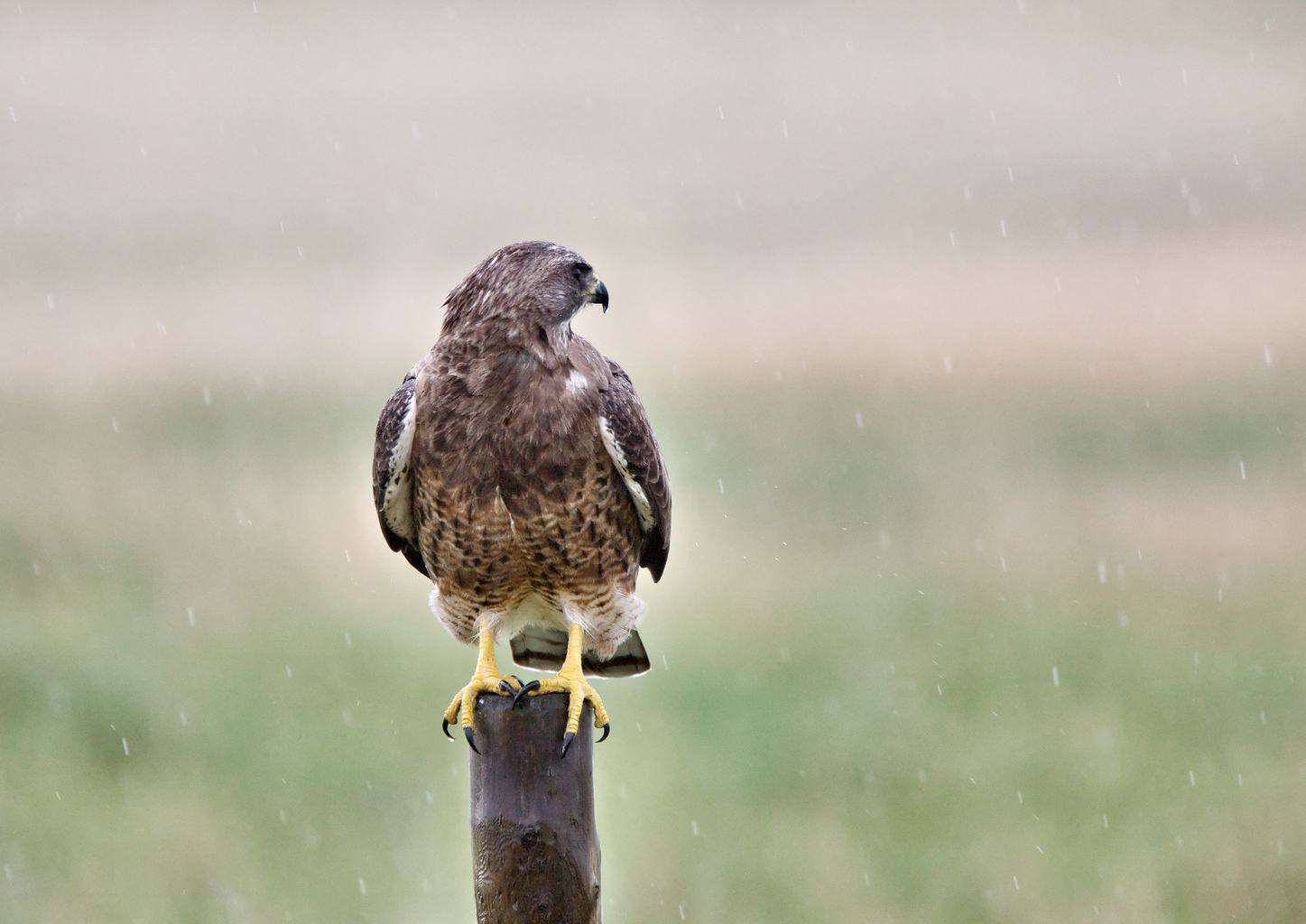
- Scientific name: Buteo swainsoni
- Length: 19-22 inches
- Weight: 24-48 ounces
- Wingspan: 46-54 inches
The beautiful and large Swainson’s hawk soars with its long wings slightly raised, resembling a V-shape. They have distinctive white underwings, gray upperparts, and reddish-brown chests.
Unlike most raptors, Swainson’s hawks are social birds of prey that are usually found in large groups. If you see a large flock soaring through the sky in April and September, they’re most likely Swainson’s hawks. They can also be seen perching on utility wires, fence posts, and isolated trees. They nest on trees in isolated areas.
Members of this species of hawks feed on insects such as dragonflies, dobsonflies, or grasshoppers, and during nesting, they feed their chicks small rodents, rabbits, and reptiles.
Cooper’s Hawk

- Scientific name: Accipiter striatus
- Length: 15 inches (males), 16.5-18 inches (females)
- Weight: 8-14.5 ounces (males), 12-24 ounces (females)
- Wingspan: 24.4-35.5 inches (males), 29.5-35.5 inches (females)
Next on our list of Pennsylvania hawks is a medium-sized bird that boasts a typical accipiter shape: Cooper’s hawk.
Adult Cooper’s hawks have long rounded tails, broad wings, reddish-pleated chests, and blue-gray backs. The dark bands on their tails are visible when they’re flying, and they can be identified while crossing large open areas by their flap-flap-glide flying pattern.
These hawks catch their prey by flying fast and close to the ground, then up and over a barrier; surprising their victim from the other side.
These birds live mostly in wooded habitats, so if you’re looking for a Cooper’s hawk specifically, they can be found in deep forests, forested mountains, leafy subdivisions, and backyards.
Broad-Winged Hawk
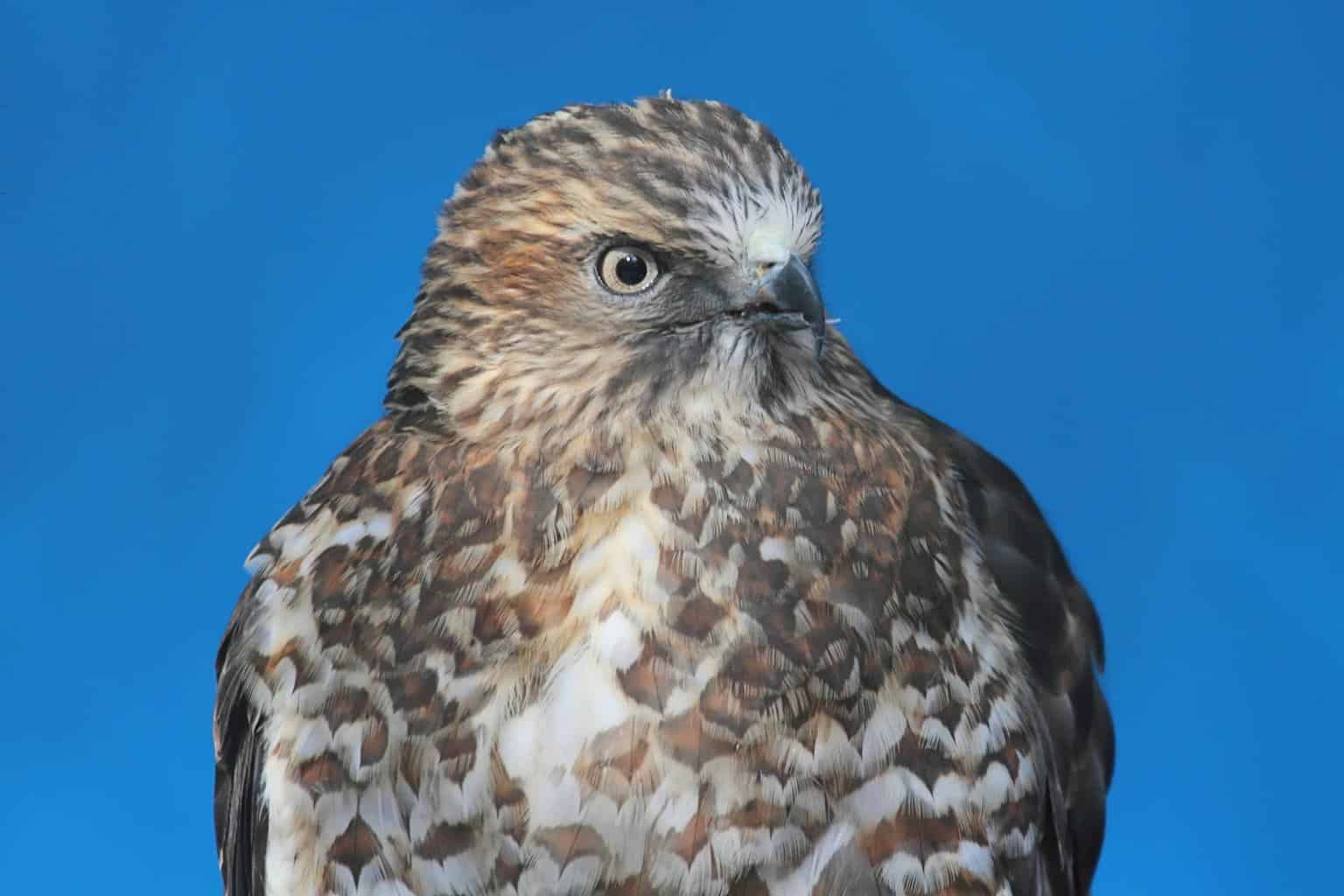
- Scientific name: Buteo platypterus
- Length: 13-17 inches
- Weight: 9-20 ounces
- Wingspan: 32-39 inches
Each fall, flocks of broad-winged hawks can be easily seen during migration at famous hawk-watch sites like Hawk Mountain in Pennsylvania. Sometimes thousands of birds fill the sky at a time as they head to Central and South America; it’s quite the sight for sure.
Broad-winged hawks are small birds with short, square tails and broad wings. They have reddish-brown chests and barred underparts, which can be seen when they’re flying. Adults have broad black-and-white bands on their tails.
These compact raptors spend most of their time underneath the forest canopy, where they can hunt small animals like mice, voles, rabbits, amphibians, smaller birds, and large insects.
You’ll likely hear this species before you see it, as their high-pitched whistle is characteristic. It’s a two-note “kee-eee” sound that lasts 2-4 seconds. To find them, just follow the sound!
Red-Tailed Hawk

- Scientific name: Buteo jamaicensis
- Length: 18-22 inches (males), 19.5-25.5 inches (females)
- Weight: 24-46 ounces (males), 32-52 ounces (females)
- Wingspan: 45-52 inches (males), 45-52 inches (females)
Meet our beautiful pal, the red-tailed hawk. This large hawk with broad, rounded wings and short tails is the most common species in North America. They can be found chilling on fence posts or soaring in circles among the clouds, just waiting to come across something to snatch up for its next meal. They feed mostly on rodents, but they also eat other types of mammals and birds of varying sizes.
These birds are mostly chocolate brown with pale underparts and streaked bellies. They also have distinctive cinnamon-red tails.
To spot a red-tailed hawk in Pennsylvania, just jump in your car and go for a drive; you’ll probably see a few on the roadside. But another easy way to find red-tailed hawks is by their loud, scratchy call. They have a thrilling cry just like the ones portrayed for hawks in the movies. Listen carefully for the “kee-eeee-aar” sound!
Northern Goshawk
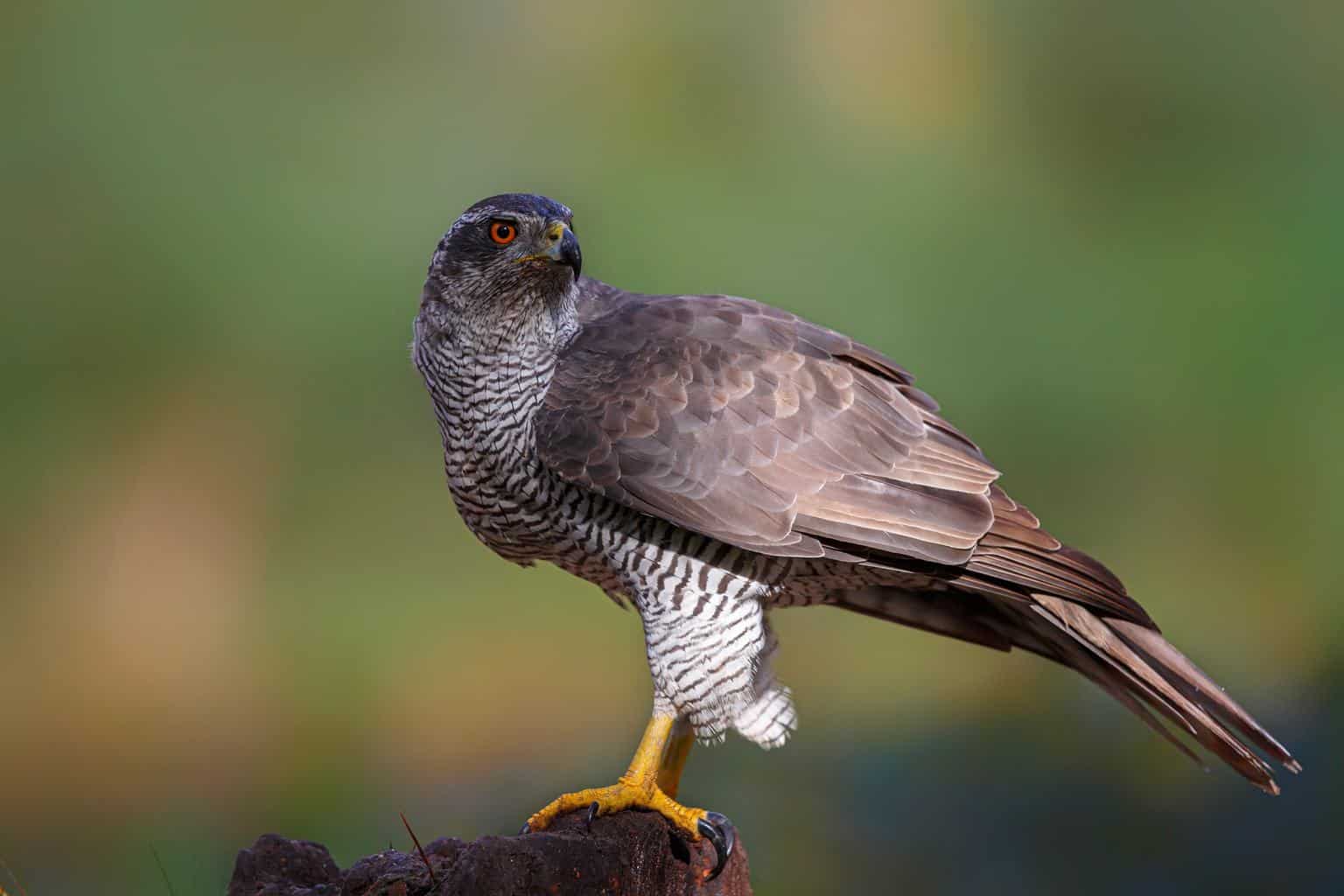
- Scientific name: Accipiter gentilis
- Length: 21-25 inches
- Weight: 22-48 ounces
- Wingspan: 40.5-46 inches
Consider the northern goshawk to be the bigger and fiercer relative of the Cooper’s hawk species. It has the typical accipiter shape, with short, broad wings and a long, rounded tail.
Northern goshawks prowl with remarkable aerial agility and rush to the ground feet first to grab their prey. They’re a little tricky to find, as they usually prefer living alone or in pairs in large tracts of forest area. If you do see one of these birds, though, think twice before approaching one, as this species of bird is highly territorial, especially when their nests are nearby.
The name goshawk comes from “goose hawk.” It refers to the raptors’ habit of preying on birds. Not only do these opportunistic predators eat birds, but they also eat various types of mammals of different sizes.
Red-Shouldered Hawk
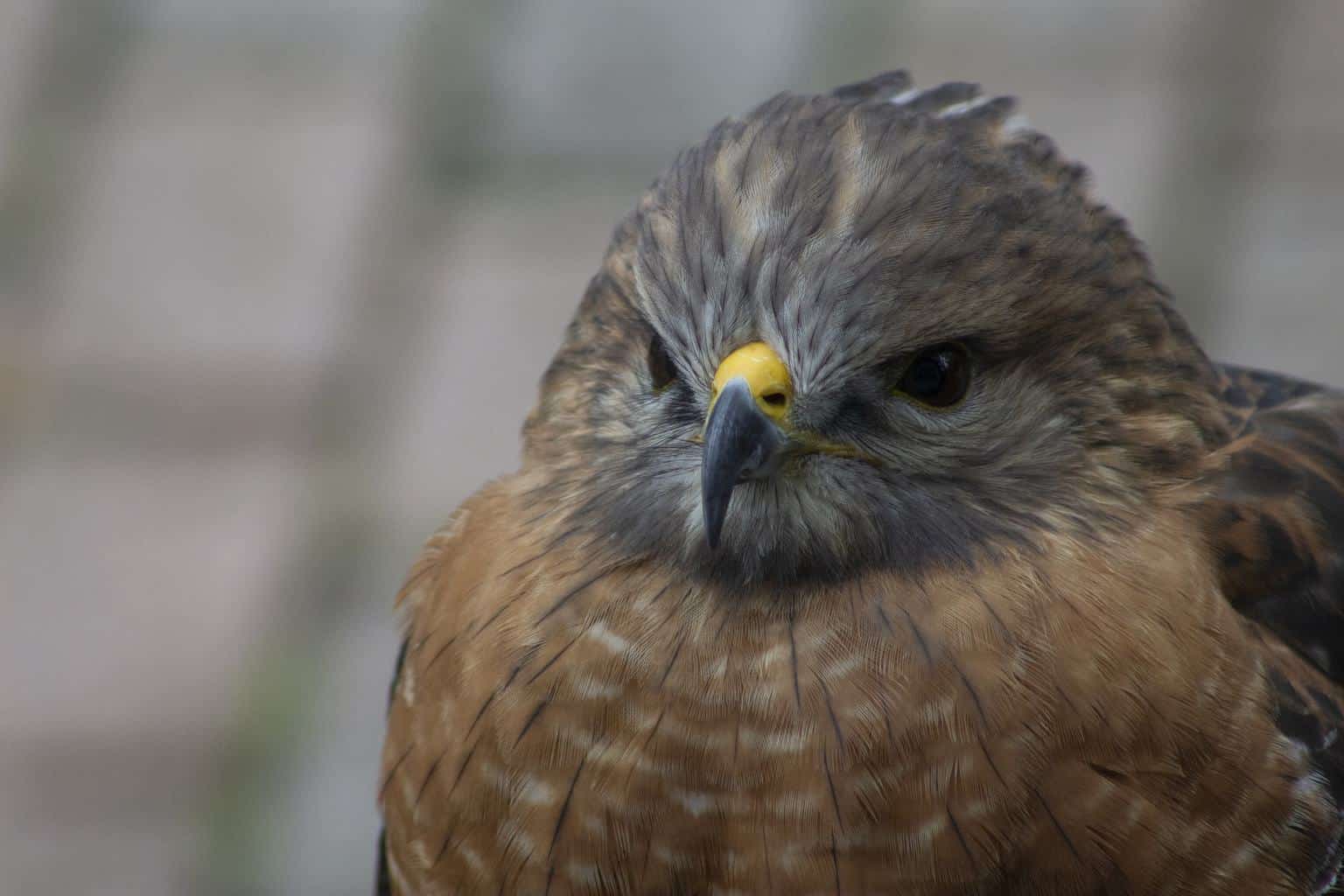
- Scientific name: Buteo lineatus
- Length: 17-24 inches
- Weight: 17-27 ounces
- Wingspan: 37-44 inches
With their broad, rounded wings and tails that fan out, red-shouldered hawks fly in a unique “reaching” posture; they push their wingtips slightly forward as they soar, so recognizing these birds in flight will be a breeze. You can easily identify them by their loud whistles, too: a distinctive “kee-aah” sound is often heard in forests.
Adults of this species have black-and-white checkered wings and warm reddish barring on their chests. And, of course, we can’t forget about their distinctive red shoulders.
These colorful hawks live in deciduous woodlands. and prefer to build their nests within massive trees. They can also be found perching on tree branches and utility wires; they use their sharp vision to search for prey from up there. Look for them near swamps and rivers, too.
These intelligent raptors hunt near their nests. That way, they can keep their prey close for later consumption. They can kill mammals of their own size using their super-strong talons.
Sharp-Shinned Hawk
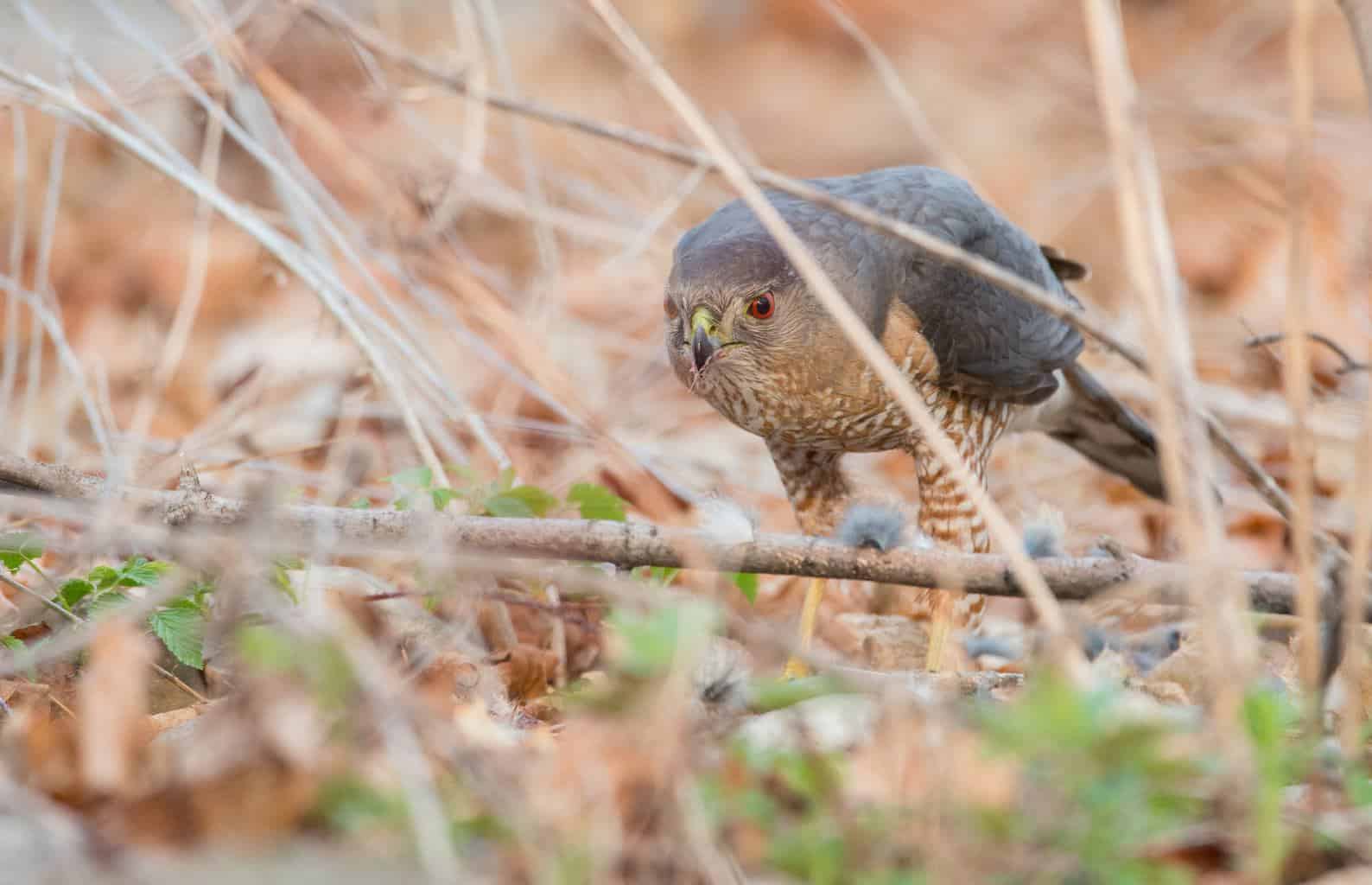
- Scientific name: Accipiter striatus
- Length: 9-13 inches
- Weight: 3-8 ounces
- Wingspan: 17-22 inches
Next up is the sharp-shinned hawk, which is not to be confused for its larger lookalike, the Cooper’s hawk species.
Sharp-shinned hawks have long tails and short, rounded wings. While adult hawks have steely blue upperparts and horizontal orange bars on the chest, sharpies of all ages have dark bands across their long square-tipped tails.
These hawks are agile fliers, but they don’t project their tiny heads beyond the wrists of the wings while flying. They speed through forest canopies to surprise their prey, which are mostly tiny songbirds. These birds have a distinctive flap-and-glide flying pattern when they fly across open areas, woodlands, and even backyards.
Sharp-shinned hawks don’t have a distinctive song or a unique raspy call, however, they use a “kik-kik-kik” sound as an alarm call during courtship. You’ll have better luck spotting a sharp-shinned hawk during fall migration. At that time, they’re the most abundant raptors at watch sites.
Rough-Legged Hawk

- Scientific name: Buteo lagopus
- Length: 18.5-20.5 inches
- Weight: 25-49 ounces
- Wingspan: 52-54 inches
Rough-legged hawks are large buteo birds with long tails and broad wingtips that are slightly swept-back, giving an M-shape to the wings.
These boldly patterned hawks feature black patches at the wrist with a white tail-base, and both dark and light morphs of rough-legged hawks have pale underwings.
Rough-legged hawks’ legs are feathered all the way to the toes, which is where they get their name, and this carnivorous species feeds on small mammals, mostly rodents. They usually fly low to scan the ground below for prey. They also steal prey from other individuals of the same species or other species.
They can be found perching on fence posts, utility wires, or treetops. Since they breed in the arctic, your best chance of finding them is during the winter season.
Northern Harrier

- Scientific name: Circus hudsonius
- Length: 18-20 inches
- Weight: 11-26.5 ounces
- Wingspan: 40-46.5 inches
A medium-sized bird of prey, the northern harrier can be identified by its flat, owl-like face, long and rounded tail, and sharply hooked bill.
When these dark birds with whitish undersides fly, they stay low to the ground, relying on both hearing and vision to capture their prey — their preferred diet includes voles, ground squirrels, and cotton rats. As they’re in flight, they hold their wings in a V-shape.
Northern harriers breed in open habitats and build their nests concealed in grasses, but you’ll most likely spot them in the sky. Look for them in wide-open fields or state parks.
Wrap Up
Unique colors and flying patterns make hawks admirable birds of prey, and it’s no wonder birders across America find them so fascinating to observe. You can also identify them by their hoarse sounds.
These intelligent creatures hunt right before sundown when the weather is warm. Bird-enthusiasts gather in the vast state parks of Pennsylvania to look for them. And if you’re lucky, you’ll see different kinds of birds in this state, too. Check out this article to know the 8 woodpecker species you can see in Pennsylvania.

